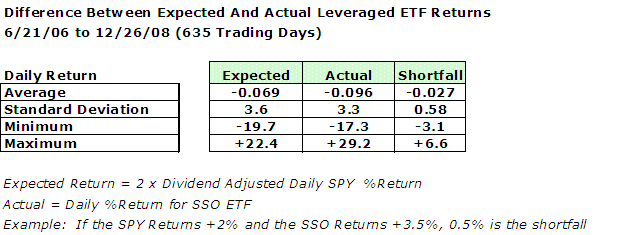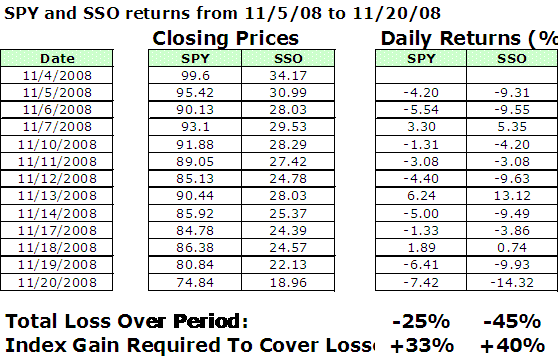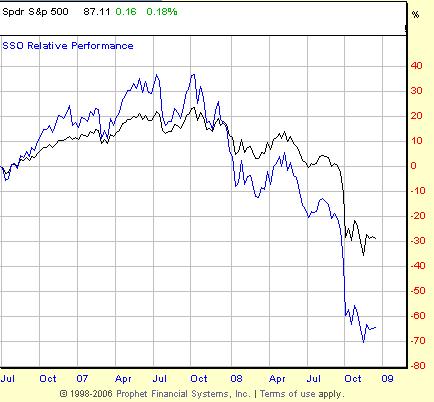What Can We Learn From the 2008 Leveraged ETF Collapse? Part 1
Was the ^SSO^ doomed to fail? In this two-part article we will show you why the ETF was and still is flawed, and what we can learn from one of the worst performing investments of the past year that will help us build better investment portfolios and leveraged trading strategies.
2008 was the year that investors were punished for the crimes of others. The value of most broad-based equity indexes fell by more than a third, and the S&P 500 itself was down about 40%. This poor index performance would seem to be all that is needed to explain the dismal performance of the corresponding leveraged ETF.
In fact, SSO never had a chance. The design of the fund trapped investors into a position in which they were almost guaranteed to lose money over the long term no matter how the S&P 500 performed. The only question was whether the losses would come quickly or slowly.
Read this innocuous fund description: “Ultra S&P 500 ProShares seeks daily investment results, before fees and expenses, which correspond to twice (200%) the daily performance of the S&P 500 Index.” This sounds ideal for an investor looking to double the potential return from an investment dollar, but has two key phrases in plain view that virtually guarantee long-term losses.
The first key phrase is “before fees and expenses”. All funds have expenses that include management fees and transaction costs, but leveraged funds have an additional expense attributable to the cost of capital associated with the increased equity exposure. We can back out the total expense level by analyzing daily returns.
In Table 1 below, we calculate the difference between the daily return of the ProShares Ultra S&P 500 ETF and the doubled daily returns of the ^SPY^. On a daily basis, the ETF provides a return about 2.7 basis points lower than we would expect. That may not sound high, but compounded the result is portfolio sticker shock: 7.1% annually.

This means that unless the S&P 500 provides an annual return of more than 7.1%, the leveraged ETF will underperform the underlying index. Or that in order for the leveraged ETF to return at least 15% in a single year, the underlying index would have to return 11%. (Add 7, divide by 2.)
While short-term investors may consider this expense just the price of admission, what will be of greater concern is the fund’s tracking error. The standard deviation of the difference between the expected and actual daily return is 58 basis points and on some days as much as 300. This variation just adds more risk to a trader’s position.
The second key phrase is “twice the daily performance”. In a volatile market this can mean huge potential losses that are difficult to recover from. In Table 2, we show a sequence in which the leveraged ETF was brought to the edge of ruin, losing almost half of its value in twelve market days.

At the end of this period, the S&P 500 has lost 25% of its value and now needs a 33% gain in order to break even. But that won’t be enough for the leveraged ETF, which now demands a 40% gain in the underlying index in order to make up the losses. It takes more effort for the leveraged ETF to recover than the underlying index.
Like the 7.1% expense, this performance penalty isn’t intuitive. Yet it’s simple multiplication. A 25% gain erases a 20% loss, but a 50% gain will not erase a 40% loss. The damage done by doubling negative returns is worse than the benefit gained by doubling positive returns.
Thus the leveraged ETF has taught us two valuable lessons: First, unexpected expenses can wipe out returns over time and significantly lower the breakeven point for an investment, and the best way to find these expenses is by comparing expected returns to actuals. And second, boosting both positive and negative returns can drive a portfolio into a ditch that is just about impossible to climb out of, even if the underlying index does recover.
In part 2 of this article, we will learn how intelligently managing a portfolio’s changing market exposure can boost returns and lower risk, and how to use that technique to build a better leveraged ETF or investment portfolio.
Tristan Yates is the author of Enhanced Indexing Strategies: Utilizing Futures and Options to Achieve Higher Performance and writes articles on index investing, options strategies, and leveraged portfolio management for Investopedia and Futures & Options Trader. He also helped lead the $1T Fannie Mae securities restatement. Yates has an MBA from INSEAD, a leading international business school.

